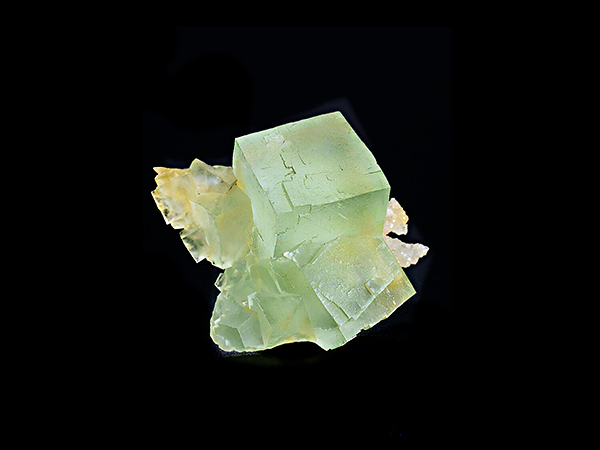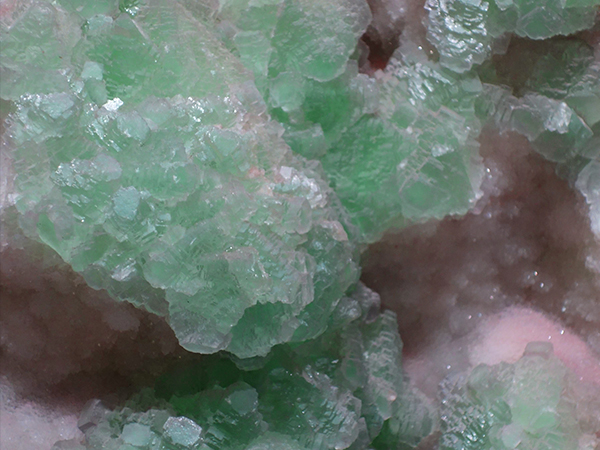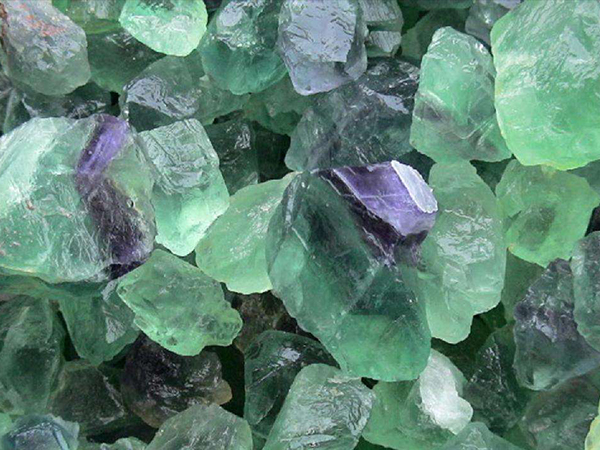FLUORITE

It crystallizes into an octahedron and a cube.Crystal is glass luster, bright and varied colors, brittle, mohs hardness of 4, melting point of 1360℃, with the property of complete cleavage.Some samples can glow when exposed to friction, heat and ultraviolet radiation.
The mineral from volcanic magma, in the process of magma cools, was separated gas aqueous solution containing fluorine, lava in the process of solution along the fissures, air fluoride ion in aqueous solution with calcium ions in the surrounding rock, the formation of calcium fluoride, after cooling crystallization formed fluorite. Exists in granite and pegmatite, syenite rock.
It is not often used as a gem because of its fragility.Fluorite is the main source of fluorine in industry and can be used to extract and prepare fluorine elements and various compounds.Fluorite specimens with bright colors and beautiful crystal morphology can be used for collection, decoration and sculpture.
Mineral history
In the neolithic age, the hemudu people in China used fluorite as decoration.The mining and excavation of fluorite originated in ancient Egypt, when people used fluorite widely to make statues and scarab shaped sculptures.
In ancient Rome, fluorite was widely used as a precious stone in wine glasses and vases. The ancient Romans even believed that fluorite glass could make people drunk.
Mineralogist, Germany, in 1529, Mr. Chris · Agricola (g. Agricola) in his book the earliest references to fluorite, in 1556 he was studying in the process of fluorite, discovered the fluorite mineral is low melting point, add a certain amount of fluorite in iron and steel smelting, not only can improve the furnace temperature, remove harmful impurities such as sulfur, phosphorus, but also with slag melt mixture, enhance the activity, liquidity, the separation of slag and metal.
In 1670, German glass worker Selewanhardt accidentally mixed fluorite with sulfuric acid to produce a chemical reaction, resulting in a kind of pungent smoke, which aroused people's attention to the chemical properties of fluorite.In 1771, Swedish chemist Carl William Scheele combined fluorite with sulfuric acid to make an acid made from hydrogen and an unknown element.

In 1797, an Italian engineer, Carlos Ant?Nio Napion names the mineral Fluorite after the Latin Fluere for "fluid."It is often used as an auxiliary solvent in smelting metals.
In 1813, French physicist Andre Marie Ampere named the unknown element once prepared by du le as fluorine, and took the first letter "F" as the symbol of the element, which was included in the seventh group of the second period of the periodic table of elements, belonging to halogen elements.
In 1825, the word Fluorescence came into being, meaning Fluorescence, due to fluorite's ability to fluoresce when exposed to ultraviolet light.
In 1886, French chemist henri Moissan isolated the gaseous fluorine element from fluorite for the first time, revealing that fluorite is a mineral composed by the combination of calcium and fluorine, and was named calcium fluoride (CaF).
The formation process
Fluorite from residue of lava, in the process of magma cools, the aqueous solution by magma isolated gas contains many substances, with fluoride is given priority to, in the process of solution along the fissures, temperature decrease, pressure is reduced, air fluoride ion in aqueous solution combined with calcium ions in the surrounding rocks, forming calcium fluoride, get the fluorite after cooling crystallization.
Growing environment
Fluorite is a subsidiary mineral in granite, pegmatite and syenite.Fluorite can be found in carbonates, alkaline intrusive rocks and beside the vents around the volcano.It is also deposited in hydrothermal veins and stratally controlled deposits.Fluorite ACTS as an adhesive at the natural junctions of sandstone.
The minerals associated with fluorite include scheelite, apatite, topaz, cassiterite, wolframite, pyrite, calcite, sphalerite, lapis lazuli, white mica, quartz, galena, dolomite, chalcopyrite, sodium feldspar, spinel, rhododenite, barite.
Crystal structure
Most crystals of fluorite are octa
hedral and cubic.There are also composite crystals where the octahedron intersects the cube.Cleavage marks are present on most crystals, and cleavage blocks exfoliated from larger crystals are common.

Fluorite crystal structure is a cubic crystal system, which is based on a face-centered dense pile formed by cation, and its tetrahedral gap position is filled by anions.Ca2+ ions are located at the node of the vertical aspect center, and the coordination number of Ca2+ is 8.The f-ion is located in the center of eight small cubes inside the cube, and the coordination number of the f-ion is 4
Natural distribution
The main fluorite deposit areas are in Cornwall, castleton, Derbyshire, durham, England.Domes, France;Mont blanc, Switzerland;Black forest, Germany;Asturias, Spain;Daliegorsk, Russia;Kalaoba, kazakhstan;Hunan, China;Chihuahua, coahuila, durango, Mexico;New York, Ohio, Illinois, Tennessee, Colorado, new Mexico;Ontario, British Columbia, Canada;Vanuko, Peru;Namibia;Pakistan.
Effective variant
Onite (Antozonite)
Some fluorite contain traces of uranium metal inside. When uranium continuously emits ionizing radiation, some of the calcium atoms in the fluorite structure gradually separate from the fluorine atoms.When the mineral breaks up, the free fluorine released can react with gaseous water to form ozone and hydrogen fluoride, which then gives off the odorous smell of ozone.
Blue John
A variety of fluorite having alternating purple and white (or purple and yellow) bands.The cause of its blue-purple stripes is not clear.Microscopic analysis failed to identify impurities such as potassium permanganate or hydrocarbons that could cause a blue-purple pattern in this variety.However, due to the dislocation of the lattice of blue fluorite, the original atomic structure of fluorite may be shifted or disturbed, and the color of the blue fluorite may be changed physically.
Chlorophane
Fluorite with thermoluminescent properties gives off a green glow when heated.Phosphor fluorite contains impurities such as manganese, aluminum, magnesium, trace amounts of iron and sodium.
Fluorite variety, chemical formula is (Ca,Y)F2.Yttrium fluorite is formed when some of the calcium in the chemical structure of fluorite is replaced only by yttrium.
The main value
Fluorite is the only mineral that can extract large amounts of fluorine.It is also used as a solvent aid in steelmaking to remove impurities.The mineral is also used in the manufacture of glass and enamel.In addition, there is a great demand for fluorite in the field of optics.Its synthetic crystals can be grown to make a variety of lenses.For example, the lens made of fluorite has very low dispersion, so the polished lens has less color difference than the lens made of ordinary glass.
Fluorite is the most brilliant gem in the world.But because of its low hardness, it cannot normally be used as jewelry.But because fluorite is soft, when crystals are large enough, it is relatively easy to use it to sculpt ornaments.This mineral is very popular among ore collectors.In particular, some well-made specimens can command high prices.
Culture legend
There is an old legend about fluorite.On a hill in ancient India, cobras are found in abundance, often clustered around a boulder.Curious people decided to find out.
People climbed the mountain in the dark and found that the boulder was emitting a faint blue light.The characteristic that tends to light makes flying bug people rush toward stone regardless of personal danger, become the cate of the frog that waits for a long time, and frog corps attracted cobra to round up again.Originally, snakes gather here to guard the "stone" to "frog".This kind of stone is fluorite.